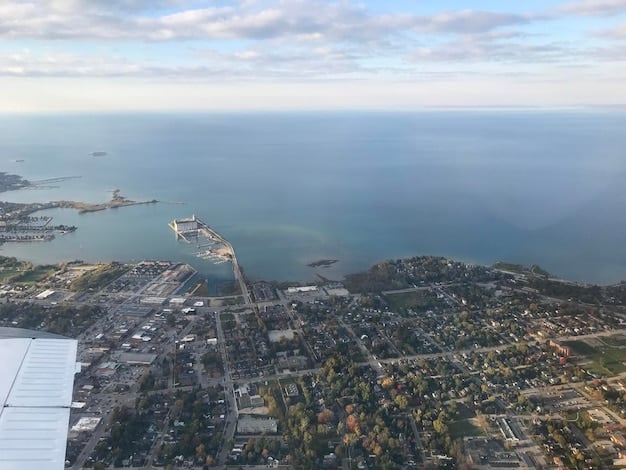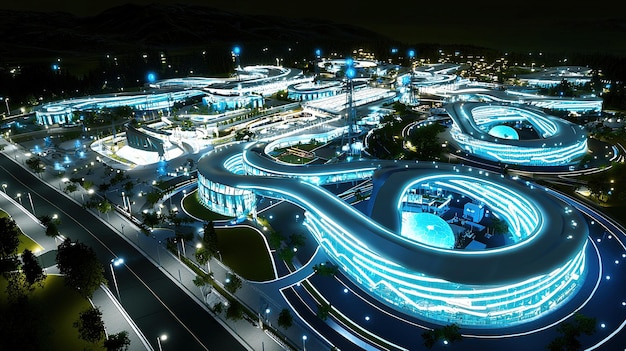Latest Innovations in US Climate-Resilient Infrastructure

The latest innovations in US climate-resilient infrastructure include advancements in materials science, smart technologies for monitoring and management, and nature-based solutions designed to mitigate climate change impacts.
As climate change continues to pose significant challenges, the United States is increasingly focused on enhancing its infrastructure to withstand these impacts. What are the latest innovations in US climate-resilient infrastructure? This article delves into the cutting-edge technologies and strategies being deployed to protect communities and assets from the growing threats of extreme weather events.
Understanding the Need for Climate-Resilient Infrastructure
Climate change is no longer a distant threat; it’s a present reality impacting communities across the US. Extreme weather events, rising sea levels, and increased temperatures are straining existing infrastructure, necessitating a shift towards more resilient solutions.
Climate-resilient infrastructure aims to minimize the damage from these events, ensuring essential services remain operational and communities can recover quickly. This involves not only upgrading physical structures but also implementing innovative technologies and strategies.
The Rising Cost of Climate Change
The financial implications of climate change are staggering. Without significant investment in resilient infrastructure, the costs associated with disaster recovery, business interruption, and public health will continue to escalate.
- Increased Disaster Frequency: The number of billion-dollar weather events has risen sharply in recent decades, highlighting the urgent need for proactive measures.
- Economic Losses: Extreme weather events can disrupt supply chains, damage property, and lead to substantial economic losses for businesses and individuals.
- Public Health Impacts: Heatwaves, floods, and other climate-related events can strain public health systems, leading to increased hospitalizations and mortality rates.
Investing in climate-resilient infrastructure is not just about protecting physical assets; it’s about safeguarding the economy, public health, and the overall well-being of communities.
Advancements in Materials Science
One of the key areas of innovation in climate-resilient infrastructure is the development and application of advanced materials. These materials are designed to withstand extreme weather conditions, resist corrosion, and offer enhanced durability.
By incorporating these materials into infrastructure projects, engineers can build structures that are better equipped to handle the challenges posed by a changing climate, reducing the need for frequent repairs and replacements.

Self-Healing Concrete
Self-healing concrete is a revolutionary material that can automatically repair cracks, extending the lifespan of infrastructure and reducing maintenance costs. Microscopic capsules containing healing agents are embedded within the concrete mix.
When cracks occur, these capsules rupture, releasing the healing agents that fill the cracks and prevent further damage. This technology is particularly beneficial for bridges, roads, and other structures exposed to harsh environmental conditions.
High-Performance Concrete
High-performance concrete (HPC) is another advanced material that offers superior strength, durability, and resistance to corrosion. HPC is designed to withstand extreme temperatures, freeze-thaw cycles, and exposure to chemicals, making it ideal for infrastructure projects in challenging environments.
- Enhanced Durability: HPC can last significantly longer than traditional concrete, reducing the need for frequent repairs and replacements.
- Improved Strength: HPC offers greater load-bearing capacity, allowing for the construction of stronger and more resilient structures.
- Corrosion Resistance: HPC is less susceptible to corrosion, making it suitable for coastal environments and areas with high levels of pollution.
The use of advanced materials like self-healing concrete and HPC is transforming the construction industry, enabling the creation of infrastructure that is more resilient and sustainable.
Smart Technologies for Monitoring and Management
In addition to advanced materials, smart technologies are playing an increasingly important role in climate-resilient infrastructure. These technologies enable real-time monitoring of infrastructure performance, allowing for proactive maintenance and timely interventions.
By leveraging sensors, data analytics, and artificial intelligence, engineers can gain valuable insights into the condition of infrastructure assets and make informed decisions to improve their resilience.
Sensor Networks
Sensor networks are deployed to monitor various parameters, such as temperature, humidity, strain, and vibration, providing a comprehensive view of infrastructure performance. These sensors can detect early signs of damage or deterioration, allowing for timely repairs and preventing catastrophic failures.

Data from these sensors is transmitted wirelessly to a central monitoring system, where it is analyzed to identify potential problems and trigger alerts.
Digital Twins
Digital twins are virtual replicas of physical infrastructure assets, created using data from sensors, inspections, and other sources. These digital models allow engineers to simulate the impact of various scenarios, such as extreme weather events, and optimize infrastructure design and management.
- Predictive Maintenance: Digital twins can be used to predict when maintenance is needed, reducing downtime and extending the lifespan of infrastructure assets.
- Scenario Planning: Digital twins enable engineers to evaluate the performance of infrastructure under different climate change scenarios and identify vulnerabilities.
- Optimized Design: Digital twins can be used to optimize the design of new infrastructure projects, ensuring they are resilient to future climate risks.
Smart technologies are revolutionizing infrastructure management, enabling a more proactive and data-driven approach to resilience.
Nature-Based Solutions
Nature-based solutions (NBS) are an increasingly popular approach to climate-resilient infrastructure. These solutions involve using natural ecosystems or engineered systems that mimic natural processes to provide a range of benefits, including flood control, erosion prevention, and water purification.
By working with nature, rather than against it, NBS can offer cost-effective and sustainable solutions to the challenges posed by climate change.
Coastal Protection
Mangrove forests, coral reefs, and other coastal ecosystems provide natural defenses against storm surge and erosion. Restoring and protecting these ecosystems can significantly reduce the impact of coastal flooding and protect coastal communities.
Engineered solutions, such as living shorelines, can also be used to enhance coastal resilience. These solutions involve using natural materials, such as sand, gravel, and vegetation, to create a more stable and resilient shoreline.
Urban Green Infrastructure
Urban green infrastructure, such as green roofs, rain gardens, and urban forests, can help mitigate the impacts of climate change in urban areas. These features can reduce urban heat island effects, absorb stormwater runoff, and improve air quality.
- Reduced Flooding: Green infrastructure can capture and store stormwater runoff, reducing the risk of flooding.
- Cooling Effect: Green roofs and urban forests can help lower temperatures in urban areas, reducing the impact of heatwaves.
- Improved Air Quality: Vegetation can absorb pollutants and improve air quality, benefiting public health.
Nature-based solutions offer a sustainable and cost-effective approach to climate-resilient infrastructure, providing a range of benefits for both communities and the environment.
Policy and Funding Initiatives
The US government is increasingly recognizing the importance of climate-resilient infrastructure and is implementing policies and funding initiatives to support its development. These initiatives aim to incentivize investment in resilient infrastructure projects and promote the adoption of innovative technologies and strategies.
By creating a supportive policy environment and providing access to funding, the government can accelerate the transition towards a more resilient and sustainable infrastructure system.
Infrastructure Investment and Jobs Act
The Infrastructure Investment and Jobs Act, signed into law in 2021, includes significant funding for climate-resilient infrastructure projects. This funding will support projects such as flood control, coastal protection, and upgrades to water and transportation infrastructure.
The act also includes provisions to promote the use of innovative technologies and nature-based solutions in infrastructure projects.
Federal Emergency Management Agency (FEMA)
FEMA provides funding and technical assistance to state and local governments for disaster preparedness and recovery efforts. The agency is increasingly focused on promoting climate resilience and helping communities build back stronger after disasters.
- Hazard Mitigation Assistance: FEMA’s Hazard Mitigation Assistance programs provide funding for projects that reduce the risk of future disasters.
- Building Codes and Standards: FEMA is working to promote the adoption of building codes and standards that incorporate climate change considerations.
- Community Resilience: FEMA supports community-led efforts to build resilience to climate change and other hazards.
Government policies and funding initiatives are essential for driving investment in climate-resilient infrastructure and ensuring that communities have the resources they need to adapt to a changing climate.
Challenges and Opportunities
While significant progress has been made in the development of climate-resilient infrastructure, challenges remain. Overcoming these challenges will require collaboration among government, industry, and communities.
By addressing these challenges and seizing the opportunities that lie ahead, the US can build a more resilient and sustainable infrastructure system.
Financial Constraints
Investing in climate-resilient infrastructure can be expensive, and many communities lack the financial resources to undertake these projects. Innovative financing mechanisms, such as public-private partnerships and green bonds, can help overcome these financial constraints.
Government incentives, such as tax credits and grants, can also encourage investment in resilient infrastructure projects.
Technical Expertise
Designing and implementing climate-resilient infrastructure requires specialized technical expertise. Building capacity through training programs and partnerships with universities and research institutions can help ensure that communities have access to the expertise they need.
- Workforce Development: Investing in workforce development programs can create jobs in the growing field of climate-resilient infrastructure.
- Knowledge Sharing: Sharing best practices and lessons learned can help accelerate the adoption of innovative technologies and strategies.
- Research and Development: Continued investment in research and development is essential for developing new and improved solutions for climate-resilient infrastructure.
Addressing these challenges and seizing the opportunities will be crucial for building a climate-resilient future for the US.
| Key Aspect | Brief Description |
|---|---|
| 🌱 Advanced Materials | Use of self-healing and high-performance concrete to enhance durability. |
| 🛰️ Smart Technologies | Implementation of sensor networks and digital twins for real-time monitoring. |
| 🌊 Nature-Based Solutions | Employing mangrove forests and green infrastructure for coastal protection. |
Frequently Asked Questions
▼
Climate-resilient infrastructure is designed to withstand the impacts of climate change, such as extreme weather events and rising sea levels, ensuring continued operation and minimal damage.
▼
It’s crucial for protecting communities, economies, and ecosystems from the increasing threats of climate change by ensuring that essential services remain operational during extreme events.
▼
Examples include reinforced seawalls, elevated roads, green infrastructure like urban forests, and buildings designed to withstand extreme weather conditions.
▼
Smart technologies like sensor networks and digital twins enable real-time monitoring and predictive maintenance, allowing for proactive interventions to prevent infrastructure failures.
▼
Nature-based solutions like mangrove forests and green roofs provide natural defenses against extreme weather and offer additional benefits, such as improved air quality and reduced urban heat island effects.
Conclusion
The latest innovations in US climate-resilient infrastructure represent a significant step forward in protecting communities and assets from the growing threats of climate change. By embracing advanced materials, smart technologies, and nature-based solutions, the US can build a more resilient and sustainable future.





